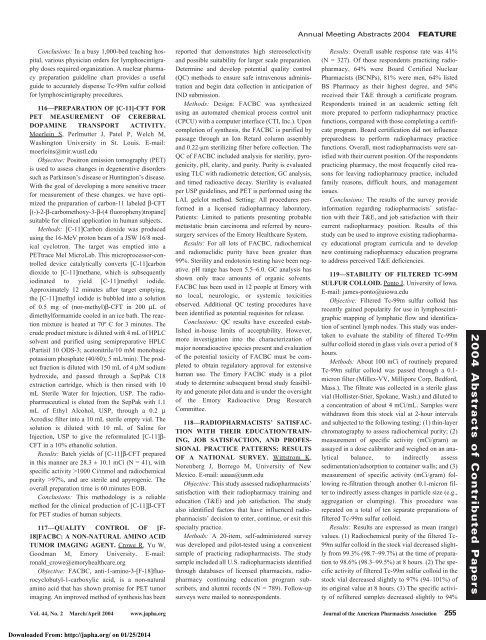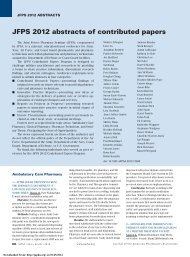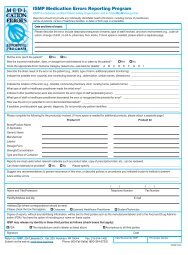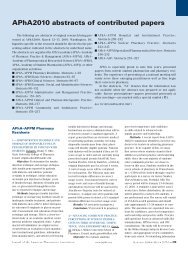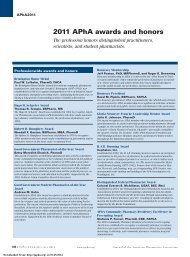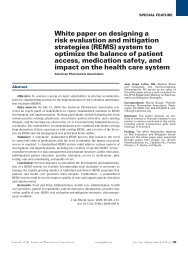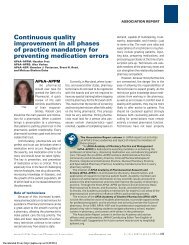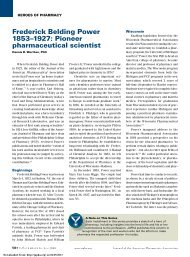Downloaded - Journal of American Pharmacists Association
Downloaded - Journal of American Pharmacists Association
Downloaded - Journal of American Pharmacists Association
You also want an ePaper? Increase the reach of your titles
YUMPU automatically turns print PDFs into web optimized ePapers that Google loves.
Annual Meeting Abstracts 2004<br />
FEATURE<br />
Conclusions: In a busy 1,000-bed teaching hospital,<br />
various physician orders for lymphoscintigraphy<br />
doses required organization. A nuclear pharmacy<br />
preparation guideline chart provides a useful<br />
guide to accurately dispense Tc-99m sulfur colloid<br />
for lymphoscintigraphy procedures.<br />
116—PREPARATION OF [C-11]-CFT FOR<br />
PET MEASUREMENT OF CEREBRAL<br />
DOPAMINE TRANSPORT ACTIVITY.<br />
Moerlein S, Perlmutter J, Patel P, Welch M,<br />
Washington University in St. Louis. E-mail:<br />
moerleins@mir.wustl.edu<br />
Objective: Positron emission tomography (PET)<br />
is used to assess changes in degenerative disorders<br />
such as Parkinson’s disease or Huntington’s disease.<br />
With the goal <strong>of</strong> developing a more sensitive tracer<br />
for measurement <strong>of</strong> these changes, we have optimized<br />
the preparation <strong>of</strong> carbon-11 labeled β-CFT<br />
[(-)-2-β-carbomethoxy-3-β-(4 fluoropheny)tropane]<br />
suitable for clinical application in human subjects.<br />
Methods: [C-11]Carbon dioxide was produced<br />
using the 16-MeV proton beam <strong>of</strong> a JSW 16/8 medical<br />
cyclotron. The target was emptied into a<br />
PETtrace MeI MicroLab. This microprocessor-controlled<br />
device catalytically converts [C-11]carbon<br />
dioxide to [C-11]methane, which is subsequently<br />
iodinated to yield [C-11]methyl iodide.<br />
Approximately 12 minutes after target emptying,<br />
the [C-11]methyl iodide is bubbled into a solution<br />
<strong>of</strong> 0.5 mg <strong>of</strong> (nor-methyl)β-CFT in 200 µL <strong>of</strong><br />
dimethylformamide cooled in an ice bath. The reaction<br />
mixture is heated at 70º C for 3 minutes. The<br />
crude product mixture is diluted with 4 mL <strong>of</strong> HPLC<br />
solvent and purified using semipreparative HPLC<br />
(Partisil 10 ODS-3; acetonitrile/10 mM monobasic<br />
potassium phosphate (40/60); 5 mL/min). The product<br />
fraction is diluted with 150 mL <strong>of</strong> 4 µM sodium<br />
hydroxide, and passed through a SepPak C18<br />
extraction cartridge, which is then rinsed with 10<br />
mL Sterile Water for Injection, USP. The radiopharmaceutical<br />
is eluted from the SepPak with 1.1<br />
mL <strong>of</strong> Ethyl Alcohol, USP, through a 0.2 µ<br />
Acrodisc filter into a 10 mL sterile empty vial. The<br />
solution is diluted with 10 mL <strong>of</strong> Saline for<br />
Injection, USP to give the reformulated [C-11]β-<br />
CFT in a 10% ethanolic solution.<br />
Results: Batch yields <strong>of</strong> [C-11]β-CFT prepared<br />
in this manner are 28.3 ± 10.1 mCi (N = 41), with<br />
specific activity >1000 Ci/mmol and radiochemical<br />
purity >97%, and are sterile and apyrogenic. The<br />
overall preparation time is 60 minutes EOB.<br />
Conclusions: This methodology is a reliable<br />
method for the clinical production <strong>of</strong> [C-11]β-CFT<br />
for PET studies <strong>of</strong> human subjects.<br />
117—QUALITY CONTROL OF [F-<br />
18]FACBC: A NON-NATURAL AMINO ACID<br />
TUMOR IMAGING AGENT. Crowe R, Yu W,<br />
Goodman M, Emory University. E-mail:<br />
ronald_crowe@emoryhealthcare.org<br />
Objective: FACBC, anti-1-amino-3-[F-18]fluorocyclobutyl-1-carboxylic<br />
acid, is a non-natural<br />
amino acid that has shown promise for PET tumor<br />
imaging. An improved method <strong>of</strong> synthesis has been<br />
reported that demonstrates high stereoselectivity<br />
and possible suitability for larger scale preparation.<br />
Determine and develop potential quality control<br />
(QC) methods to ensure safe intravenous administration<br />
and begin data collection in anticipation <strong>of</strong><br />
IND submission.<br />
Methods: Design: FACBC was synthesized<br />
using an automated chemical process control unit<br />
(CPCU) with a computer interface (CTI, Inc.). Upon<br />
completion <strong>of</strong> synthesis, the FACBC is purified by<br />
passage through an Ion Retard column assembly<br />
and 0.22-µm sterilizing filter before collection. The<br />
QC <strong>of</strong> FACBC included analysis for sterility, pyrogenicity,<br />
pH, clarity, and purity. Purity is evaluated<br />
using TLC with radiometric detection, GC analysis,<br />
and timed radioactive decay. Sterility is evaluated<br />
per USP guidelines, and PET is performed using the<br />
LAL gelclot method. Setting: All procedures performed<br />
in a licensed radiopharmacy laboratory.<br />
Patients: Limited to patients presenting probable<br />
metastatic brain carcinoma and referred by neurosurgery<br />
services <strong>of</strong> the Emory Healthcare System.<br />
Results: For all lots <strong>of</strong> FACBC, radiochemical<br />
and radionuclidic purity have been greater than<br />
99%. Sterility and endotoxin testing have been negative.<br />
pH range has been 5.5–6.0. GC analysis has<br />
shown only trace amounts <strong>of</strong> organic solvents.<br />
FACBC has been used in 12 people at Emory with<br />
no local, neurologic, or systemic toxicities<br />
observed. Additional QC testing procedures have<br />
been identified as potential requisites for release.<br />
Conclusions: QC results have exceeded established<br />
in-house limits <strong>of</strong> acceptability. However,<br />
more investigation into the characterization <strong>of</strong><br />
major nonradioactive species present and evaluation<br />
<strong>of</strong> the potential toxicity <strong>of</strong> FACBC must be completed<br />
to obtain regulatory approval for extensive<br />
human use. The Emory FACBC study is a pilot<br />
study to determine subsequent broad study feasibility<br />
and generate pilot data and is under the oversight<br />
<strong>of</strong> the Emory Radioactive Drug Research<br />
Committee.<br />
118—RADIOPHARMACISTS’ SATISFAC-<br />
TION WITH THEIR EDUCATION/TRAIN-<br />
ING, JOB SATISFACTION, AND PROFES-<br />
SIONAL PRACTICE PATTERNS: RESULTS<br />
OF A NATIONAL SURVEY. Wittstrom K,<br />
Norenberg J, Borrego M, University <strong>of</strong> New<br />
Mexico. E-mail: aaaaa@unm.edu<br />
Objective: This study assessed radiopharmacists’<br />
satisfaction with their radiopharmacy training and<br />
education (T&E) and job satisfaction. The study<br />
also identified factors that have influenced radiopharmacists’<br />
decision to enter, continue, or exit this<br />
specialty practice.<br />
Methods: A 20-item, self-administered survey<br />
was developed and pilot-tested using a convenient<br />
sample <strong>of</strong> practicing radiopharmacists. The study<br />
sample included all U.S. radiopharmacists identified<br />
through databases <strong>of</strong> licensed pharmacists, radiopharmacy<br />
continuing education program subscribers,<br />
and alumni records (N = 789). Follow-up<br />
surveys were mailed to nonrespondents.<br />
Results: Overall usable response rate was 41%<br />
(N = 327). Of those respondents practicing radiopharmacy,<br />
64% were Board Certified Nuclear<br />
<strong>Pharmacists</strong> (BCNPs), 81% were men, 64% listed<br />
BS Pharmacy as their highest degree, and 54%<br />
received their T&E through a certificate program.<br />
Respondents trained in an academic setting felt<br />
more prepared to perform radiopharmacy practice<br />
functions, compared with those completing a certificate<br />
program. Board certification did not influence<br />
preparedness to perform radiopharmacy practice<br />
functions. Overall, most radiopharmacists were satisfied<br />
with their current position. Of the respondents<br />
practicing pharmacy, the most frequently cited reasons<br />
for leaving radiopharmacy practice, included<br />
family reasons, difficult hours, and management<br />
issues.<br />
Conclusions: The results <strong>of</strong> the survey provide<br />
information regarding radiopharmacists´ satisfaction<br />
with their T&E, and job satisfaction with their<br />
current radiopharmacy position. Results <strong>of</strong> this<br />
study can be used to improve existing radiopharmacy<br />
educational program curricula and to develop<br />
new continuing radiopharmacy education programs<br />
to address perceived T&E deficiencies.<br />
119—STABILITY OF FILTERED TC-99M<br />
SULFUR COLLOID. Ponto J, University <strong>of</strong> Iowa.<br />
E-mail: james-ponto@uiowa.edu<br />
Objective: Filtered Tc-99m sulfur colloid has<br />
recently gained popularity for use in lymphoscintigraphic<br />
mapping <strong>of</strong> lymphatic flow and identification<br />
<strong>of</strong> sentinel lymph nodes. This study was undertaken<br />
to evaluate the stability <strong>of</strong> filtered Tc-99m<br />
sulfur colloid stored in glass vials over a period <strong>of</strong> 8<br />
hours.<br />
Methods: About 100 mCi <strong>of</strong> routinely prepared<br />
Tc-99m sulfur colloid was passed through a 0.1-<br />
micron filter (Millex-VV, Millipore Corp, Bedford,<br />
Mass.). The filtrate was collected in a sterile glass<br />
vial (Hollister-Stier, Spokane, Wash.) and diluted to<br />
a concentration <strong>of</strong> about 4 mCi/mL. Samples were<br />
withdrawn from this stock vial at 2-hour intervals<br />
and subjected to the following testing: (1) thin-layer<br />
chromatography to assess radiochemical purity; (2)<br />
measurement <strong>of</strong> specific activity (mCi/gram) as<br />
assayed in a dose calibrator and weighed on an analytical<br />
balance, to indirectly assess<br />
sedimentation/adsorption to container walls; and (3)<br />
measurement <strong>of</strong> specific activity (mCi/gram) following<br />
re-filtration through another 0.1-micron filter<br />
to indirectly assess changes in particle size (e.g.,<br />
aggregation or clumping). This procedure was<br />
repeated on a total <strong>of</strong> ten separate preparations <strong>of</strong><br />
filtered Tc-99m sulfur colloid.<br />
Results: Results are expressed as mean (range)<br />
values. (1) Radiochemical purity <strong>of</strong> the filtered Tc-<br />
99m sulfur colloid in the stock vial decreased slightly<br />
from 99.3% (98.7–99.7%) at the time <strong>of</strong> preparation<br />
to 98.6% (98.3–99.5%) at 8 hours. (2) The specific<br />
activity <strong>of</strong> filtered Tc-99m sulfur colloid in the<br />
stock vial decreased slightly to 97% (94–101%) <strong>of</strong><br />
its original value at 8 hours. (3) The specific activity<br />
<strong>of</strong> refiltered samples decreased slightly to 94%<br />
2004 Abstracts <strong>of</strong> Contributed Papers<br />
Vol. 44, No. 2 March/April 2004 www.japha.org <strong>Journal</strong> <strong>of</strong> the <strong>American</strong> <strong>Pharmacists</strong> <strong>Association</strong> 255<br />
<strong>Downloaded</strong> From: http://japha.org/ on 01/25/2014


